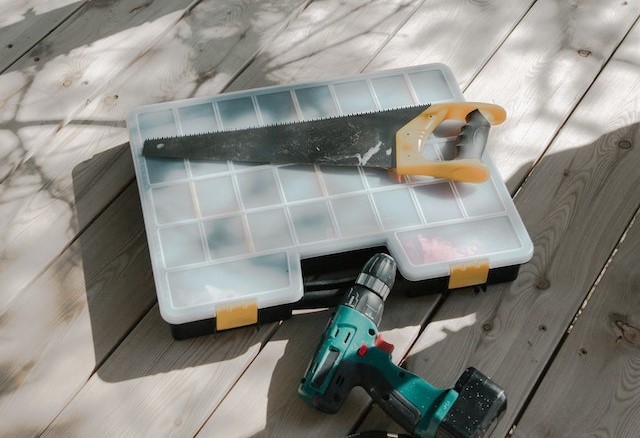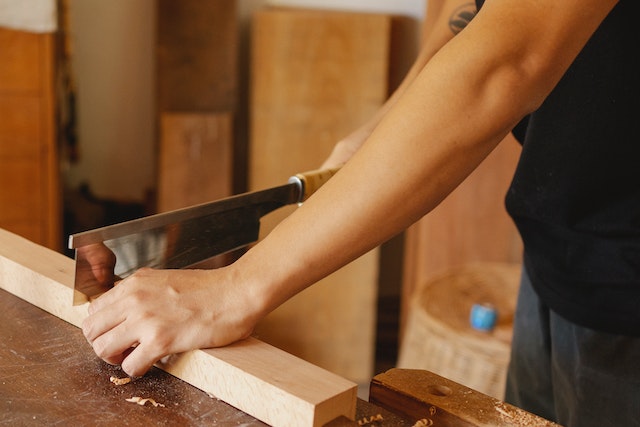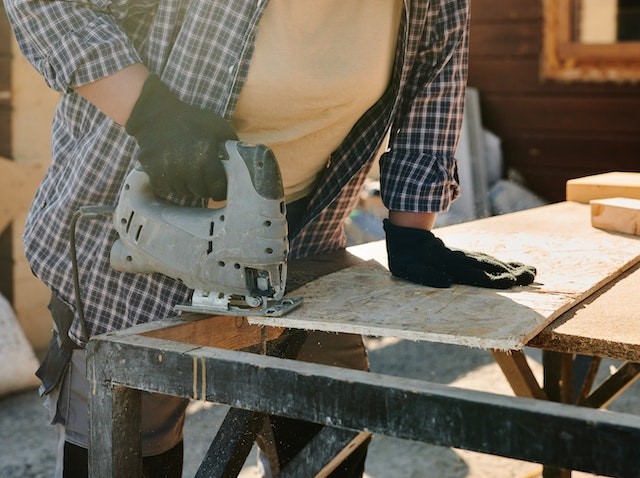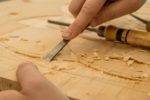The Ultimate Guide To Choosing The Right Saw

Saws are one of the most important tools in any woodworker’s arsenal, but with so many different types of saws available, it can be overwhelming to choose the right one for your needs. Whether you’re a seasoned professional or a beginner, it’s important to select the right saw for the job to ensure the best results. In this article, we’ll provide you with the ultimate guide to choosing the right saw, including the different types of saws available and their uses, as well as factors to consider when selecting the right saw for your project. So let’s dive in and learn how to make an informed decision when it comes to selecting the right saw for your woodworking needs.
Introduction to Saw Types
If you’re looking to get some cutting done and don’t want to pay an arm and leg for it, you’re in the right place. It’s essential that you understand the types of saws out there before you decide which one to buy. Let’s break them down one by one.
First up is the Hand saw. What you’d generally think of when you hear the word saw, this is an all-purpose tool that can be used for a number of tasks. It’s typically made from a wooden handle with a metal blade and features a series of sharpened teeth that cut wood, metal and plastic.
Next we have the Crosscut saw, also known as carpenter’s saw and often confused with a coping saw. It’s specially designed for cutting joins in wood and features a wide, straight blade and longer handle.
The Hacksaw is a type of saw that’s made for cut-outs in wood, metal and plastic. While similar to the Hand saw, the difference is that a Hacksaw has a proper handle for easier use and the blade is thinner than that of the Hand saw.
The Backsaw is a smaller version of the Hand saw, usually around six inches long. It has a comfortable handle and is designed to make fine, precise cuts in smaller boards.
The Miter saw is designed for making accurate crosscuts in larger pieces of wood. It has a circular blade that spins at high speed and is able to make consistent and repeatable cuts.
The Table saw is the big daddy of saws. It’s the professional choice for big projects, like trimming lumber and hardwoods. It’s usually the most expensive type of saw, but you can get some serious results with it.
The Jigsaw is specifically designed for cutting curves in wood and is one of the most versatile saws out there. It has a handheld power tool design and a variety of curved blades to choose from.
The Reciprocating saw is sort of like a jigsaw on steroids. It has a thicker blade that can be detached and replaced with blades designed for different materials. It’s mostly used for demolition work.
Finally, we have the Circular saw. This is another all-purpose saw that can be used to make cuts straight through wood, metal and plastic. It’s a power tool design with a circular blade and a handle.
That’s it for saw types! Now that you know what’s out there, it’s time to decide which one is best for you and your projects.
Hand saw

If you’re planning a DIY project that involves sawing, then you need to know about hand saws. Hand saws are the oldest type of saw, and they still have a major place in woodworking and timber carpenters’ arsenals.
Now, don’t let the word ‘hand’ fool you – these saws are still capable of amazing things! In the skilled hands of a master carpenter, a hand saw can be used to make precise cuts on woods of all types.
Hand saws are listed in different sizes, from small 7” saws to large 24” saws. The most common used saws are 12” and 16”. The saw size used will depend on the size of your project and the type of material you’re working with. Hand saws come with long and thin cutting blades that range from 4-7 teeth per inch (TPI) depending on the blade type.
We all know that saws work by pushing or pulling a blade through the material. Hand saws are no exception. But the real difference between hand and power saws is that with hand saws, you need to apply pressure manually and keep the blade straight as you cut. This requires some practice and skill.
But a few lessons and you’ll be a pro in no time! You’ll have to use some elbow grease and the process might be a bit slower than with power saws, but with hand saws, you will have more control over your cuts and you’ll be able to channel your innerwoodworker.
Now, if this sounds intimidating, don’t worry – there are also various types of hand saws available for different woodcutting projects. A carpenter’s backsaw, for example, has a thin blade and very fine teeth for precise cuts. On the other hand, a crosscut saw is wider and with thicker teeth, designed for cutting broad surfaces such as logs and boards.
Not to mention that hand saws are also lightweight and they don’t require electricity or gas to work, so they’re a great choice if you have limited space.
And there are even different types of handle shapes, such as a pistol grip or a straight handle, depending on the type of cut and material, so pick the one that fits better your working needs.
Crosscut saw
Hey there folks, today we are talking about one of the most important tools in the woodworking pantry – the Crosscut Saw!
You may be familiar with other saws such as hand saws, miter saws, and jigsaws and you are probably wondering what makes the Crosscut Saw so special.
Well, this saw has been around for centuries and is one of the most versatile tools available when it comes to making precision cuts in wood or aluminum.
Unlike with hand saws, the Crosscut Saw is designed to give you cleaner and more accurate cuts with fewer chipping or splintering.
The unique design of the Crosscut Saw makes it a great pick when it comes to cutting large pieces of wood in an efficient and accurate manner, making this saw a must-have for any professional or hobbyist woodworker.
The saw blade of a Crosscut Saw will usually come in one of two sizes, which are the 14-inch and 18-inch. These two sizes give the maximum versatility for making a variety of cuts.
The Crosscut Saw also features a unique tooth design on the blade, which helps create smooth and accurate cuts.
Like other saws, Crosscut Saws can be paired with different jigs or stands for added stability and precision, such as the miter box and hand router.
And when it comes to safety, the Crosscut Saw is no slouch. The saw has a guard around the blade to ensure that you don’t cut yourself or your workpiece.
In short, the Crosscut Saw is one of the most powerful and versatile saws available, making it an invaluable tool for any woodworker. So make sure to add one to your collection soon!
Hacksaw

Welcome to the ultimate guide to choosing the right saw! Today we’re gonna talk about hacksaws!
A hacksaw is a versatile saw that’s commonly used for cutting metal, plastic, and other materials. A hacksaw is what you need for smaller jobs like making jewelry, repairing pipes, or light plumbing work. It’s also great for cutting through sheet metals like aluminum and steel.
The way a hacksaw works is simple. It has a handle, usually made of wood or plastic. In the middle of the wooden handle, there’s a metal blade with multiple teeth that are designed to cut through metal and other materials. This blade is held in place by a clamp or set screw.
When using a hacksaw, make sure that you have a secure grip so that you don’t injure yourself while using the saw. Make sure to use tension on the blade and cut your material with a slow, steady motion. You should also make sure that you use a hacksaw blade thick enough to cut through your material effectively.
When switching blades, make sure to clean the saw of any materials or dust and tighten the set screw before replacing the blade. You also want to make sure that the teeth of the new blade are facing the right direction, as certain materials require a certain edge type.
Finally, when using a hacksaw, you should remember to wear safety goggles, gloves and a dust mask to protect yourself from flying particles. Always be aware of your surroundings and make sure that you’re not in danger of coming into contact with hot materials or pieces of metal.
And that’s it for our guide to hacksaws. Hopefully this guide has given you a better understanding of the different types of saws and how to use them. Check back soon and let’s see what else we can learn about saws!
Backsaw
You’ve probably heard of a handsaw, a crosscut saw, and a hacksaw, and now comes the backsaw. This is a saw written in the stars, created by the gods and specified in the four corners of the earth. But all joking aside, the backsaw is one of the most versatile and useful saws on the market and is perfect for both fine cutting and tough job site work.
So, what is a backsaw? A backsaw is a handsaw with a reinforced spine and matching stiffening back (hence the name). This is great for making accurate and even cuts in a variety of materials. Plus, the reinforcement increases the longevity of the saw, making it perfect for regular use.
There are a few main types of backsaw: the crosscut backsaw, the dovetail backsaw, and the tenon backsaw. The crosscut backsaw is perfect for cutting across the grain of wood and is fantastic for general woodworking or can be used as a finish carpentry tool. It’s ideal for cutting a variety of blades and usually has a fairly fine blade and measuring between eight and twelve inches long.
The dovetail backsaw is designed specifically for cutting dovetail joinery. The dovetail backsaw has very thin blades with teeth that are set in bevels. This allows the saw to make precise angled cuts that are necessary for dovetailing.
The tenon backsaw is built for cutting precise joints for furniture-making. With blades that are typically no wider than one and a half inches, the tenon saw is able to cut the precise and intricate lines often required for furniture and cabinetry.
When choosing a backsaw, there are a few things you should consider. Of course, first and foremost, the size of the blade is important. You want a blade big enough to handle the tasks at hand, but not so long that it becomes unwieldy. Also, the pitch and set of the teeth are important as they dictate how rough or precise the cut will be.
Plus, your needs in terms of size, shape, and weight will vary depending on the work you need to do. For example, if you’re doing delicate work, you may want something that’s lightweight and with a very fine blade. Conversely, if you are doing something more rugged and tough, you can opt for a heavier and sturdier saw with a thicker blade.
When you’re choosing a backsaw, remember to pick one that’s suited to your project and one that you feel comfortable with. After all, it’s not just about getting the job done, it’s about picking the right saw for the job so you can do it in the most efficient and enjoyable way possible.
Miter saw
When it comes to saws, the miter saw is the rockstar of the family. Often referred to as a chop saw or a drop saw, this saw uses a circular blade that allows it to make two types of cuts; the crosscut and miter. As the name suggests, the miter saw manipulates the blade to form sharp miter or beveled cuts in the material. The crosscut on the other hand, is simply an up-and-down cut that slices across the width of the material you’re working with.
When it comes to convenience, the miter saw is a real powerhouse. Its motor is usually attached to a movable arm and head, which can be adjusted up and down depending on the type of cut you’re trying to make. This means you don’t have to move the material you are cutting; you just move the miter saw head. Pretty awesome, right?
Plus, the miter saw can handle cuts wider than its blade. Since you can move the miter saw arm to fit various material sizes, you can make wider cuts that would normally require multiple passes from other saws.
But the best thing about miter saws is their convenience and accuracy. The arm, head and blade can quickly be set at angles to get those difficult angle and miter cuts precisely. Unlike a handheld circular saw, with this saw, you can be confident that your cuts are level, mitered, and accurate.
So if you’re looking for a saw to make precise miter, bevel, and crosscuts, any miter saw will get you there faster and more efficiently than any other tool.
Table saw
Ah ha, are ya looking for something to cut that won’t run out of breath? Look no further, ‘cuz table saws have arrived at the party!
Table saws are a fixed saw that’s positioned on a flat surface and then operated via a motor. They are one of the most popular and reliable saws for cutting any type of wood, plastic, metal and other materials with precision and ease. Just think, you can finally say goodbye to uneven pieces of wood.
But it gets even better! Table saws come with a variety of advanced features like adjustable miter gauges, telescoping fence rails and roller extensions to rip larger boards. And with blade sizes ranging from 10 to 12-inches, you’ll have plenty of room to create wide crosscuts that’s perfect for sheet board cutting.
Plus, they’re safer than hand saws. With features like metal guards, kickback pawls and anti-kickback devices that prevent a hazardous situation in case something unexpected happens. Not to mention, a dust port so you won’t have to splinter and sneeze with sawdust all over the place.
If you’re starting to feel the love for table saws, don’t stop there! They come with varying motor speeds, usually from 3000 to 5000 RPM. And with the direct drive and belt drive options, you can tell your friends you’ve got the power to cut through even the toughest materials and end up with a cut that you can be proud of.
Now that you know the deal with table saws, get ready to get your hands on the right saw for your needs. Whether you’re a master woodworker making furniture or an amateur DIY’er building whatever catches your fancy, table saws can deliver the precise and time-saving performance that you need.
Go ahead, get ready to crosscut, rip and miter your way to success with table saws! And don’t forget your googly eyes and protective gear to stay safe and injury-free.
Jigsaw
Welcome to section 1.7 of this Ultimate Guide. We are now going to explore the last saw in this section, the jigsaw. If you thought saws couldn’t get any more crazy then you would be wrong! The jigsaw is easily one of the craziest saws out there. It is like a many-toothed saw blade with an electric motor attached.
If you are looking to make curved or intricate cuts then you have come to the right saw. It is most commonly used for cutting curves in wood or metal, but it can also be used for making straight cuts in materials like plywood.
The jigsaw has a reciprocating blade that is powered by a motor. You use this saw by placing the blade against the material which you want to cut and then guiding the saw along the line you want to cut. The blade will then go up and down rapidly, cutting the material with each stroke.
The jigsaw is incredibly versatile because it has a wide range of blades available to do different types of jobs. Do you need to make a straight cut? There is a blade for that. Circles? There is a blade for that too.
Although the jigsaw is powerful and versatile, it is a bit scary to use. There is always a risk of kickback which will send the blade flying at you and back towards the material you are cutting. That is why it is important to use the appropriate safety gear and to be extra cautious when guiding the blade.
So that is it for the jigsaw in this Ultimate Guide to Choosing the Right Saw. Don’t let the fear of kickback sway you away from this powerful and versatile saw. With the proper safety gear and a bit of practice, you can make some amazing projects with the jigsaw.
Reciprocating saw

It’s a funny looking thing with a long saw blade that’s attached to a handle. But don’t let the funny looks fool you. This saw is capable of doing some powerful work.
The principle behind a reciprocating saw is the same as that of a hand saw, but with a few important differences. A reciprocating saw uses a motor to power the blade, rather than relying on manual labor to push the blade through. This allows users to cut through materials a lot faster and more efficiently. Furthermore, the blades used in a reciprocating saw are usually much thicker than most hand saws, making it capable of cutting through tougher materials with ease.
There are a variety of reciprocating saws on the market, each designed for a specific task. The main types of saws include corded saws, cordless saws, plunge saws, and variable speed saws. Corded saws are the most powerful type, while variable speed saws are better suited for fine-tuning. Whatever you end up choosing, make sure the blade is designed to work with your intended material.
Reciprocating saws are used to cut a variety of materials, including wood, plastics, and metal. They can be used for fine, detailed work or for more aggressive cutting jobs. It all depends on the type of saw, the material, and the job you have in mind. With the right blade and proper technique, you can easily tackle any project.
Reciprocating saws can be dangerous if used incorrectly. Always use the proper safety equipment and make sure to follow manufacturers’ instructions. Read up on safety tips and always be aware of your surroundings before getting started.
The ultimate guide to choosing the right saw wouldn’t be complete without mentioning the reciprocating saw. This powerful tool can speed up your work, giving you clean and precise cuts in no time. As long as you follow the right safety guidelines, you can be sure to get the job done right with a reciprocating saw.
Circular saw
Greetings, folks! This is me in the house with an exclusive guide on the world of saws. Now, we’ve already gone through so many different types like hand saws, crosscut saws, hacksaws, miter saws, table saws, and jigsaws, and all of those are great. But I’m now gonna introduce you to something special and it’s called the circular saw.
As the name suggests, this type of saw is literally circular, and if you look closely, it has a long blade which is driven by a powerful electric motor. In terms of design, it looks like a regular handsaw, with the difference being the abrasive thin disk that rotates at high speeds. And did I mention that this baby goes up to 5000 RPM?! It’s fast, but it’s also very effective in cutting through materials like wood, laminates, plastics, fibreglass, and even metal if you get the right blade.
In terms of performance, the circular saw is ideal for making straight cuts and crosscuts on large materials. But it should be handled with care as a lot of injuries happen due to its high power and rapid movements. That said, a circular saw can be a great addition to any tool box for carpentry work or for DIY projects at home.
In terms of operation, the circular saw is fairly straightforward. You just need to pick the right blade for the particular material you’re cutting and make sure the saw is running at peak power. Basically, the higher the speed, the better the results, so be sure to get the job done in as few revolutions as possible.
Also, one thing to keep in mind is to never push the saw too hard, no matter what. Doing so can force the saw out of its groove and cause the blade to bind up. This can be dangerous, so keep that in mind the next time you’re working with a circular saw.
Bam! That’s pretty much all you need to know about the circular saw and I’m sure you’re gonna have a blast working with this piece of sawing awesomeness.
Alright folks, that’s all from me in this portion of the Ultimate Guide to Choosing the Right Saw. Until next time… stay safe and keep sawing away! Till we meet again! Peace out!
How To Choose The Right Saw
Hey there guys! If you’ve come here looking for guidance in choosing the right saw, then you’re in the right place. Choosing the right saw can be an intimidating task because there are so many different types to consider. But don’t worry, this guide will help you thoroughly understand the details of different saw types so you can make the right choice.
First, the basics: Know your materials. This will help you determine what type of saw is best for your application. For example, if you need to cut through wood, then you’ll probably want to select a saw designed for that purpose. However, if your project requires you to cut through metal, then you’ll need a saw designed for that specific material.
Next, check saw features. Look for features such as the number of blades and angles the blades are at. Certain saws are designed to cut certain angles or shapes and using the wrong saw could be dangerous.
Then, consider size. Different types of saws vary in size, so it’s important to make sure the saw you choose is the right size for the job. Some jobs may require a larger saw while others may only require a small one.
Finally, check the price and warranty. Many saws come with warranties, so it is important to do your research and figure out which saw is the best to buy depending on the amount of money you have allocated for the sawing job.
Okay guys, that’s all there is to it! Now you should have a better understanding of what type of saw is best for you. After you have everything figured out, it’s time to get to work! Just make sure you follow the safety protocols so you don’t hurt yourself or damage your materials. Thanks for letting me help and good luck!
Know Your Materials

Do you ever look at a pile of materials and just not know where to start? Before you buy any saw, you’ll need to understand what type of material you’re going to be working with. Different saws work better with different materials, and understanding what material you’re working with can save you a lot of time and energy in the long run.
Let’s take a look at the common materials you may run across.
Wood is one of the most common materials and is used for a wide variety of projects. Working with wood can be tricky, and there are many types of saws specifically designed to handle the job. If you’re working with wood, you’ll need to determine which type is best suited to the job. Knowing what type of wood you’re working with will help you find the right saw. Soft woods like pine and cedar are great for carving, while harder woods like oak and walnut are better for cutting and chopping.
Metal is another material that needs special attention when choosing a saw. Cutting metal is a difficult job that requires the right saw or blade. If you’re going to be working with metal, you’ll need to make sure you choose a saw that’s designed to handle this type of material. You’ll also need to pay attention to the type of metal you’re working with as different metals will require different blades.
Plastic is a common material that’s used for all sorts of projects. Working with plastic requires a specific saw, as some saws won’t be able to handle this material. Before you do any cutting or filing, you’ll need to determine which type of saw or blade you need to get the job done.
Once you know what material you’re going to be working with, you can narrow down your saw choices. This is the first step to finding the right saw for the job and will make the whole process much easier. Remember that not all saws can work with all materials, so be sure to read the instructions carefully before you make a purchase. Now you know the basics about materials, and are ready to choose the right saw for the job.
Check Saw Features
When choosing the right saw, the features are just as important as the type of saw. You need to know things like the power source, blade speed, adjustment options, and overall maneuverability. Depending on the type of saw, each of these features can vary.
Let’s take the handheld miter saw as an example. This type of saw is designed for smaller, detailed projects. It’s light and easy to use, so you don’t need any heavy tools or machinery. But that doesn’t mean you don’t need to check its features.
You want to make sure the miter saw has the correct type of blade for the job. Keep in mind that the size of the blade determines the depth of the cut, so choose the one that’s best suited for the task.
Also, check the blade speed of the saw. You want a blade that spins fast enough to cut through the material as efficiently as possible. This also keeps the saw from getting bogged down if it’s something like wood or plastic.
Finally, you want to think about the adjustments available. You want to make sure that you can easily change the angle, tilt, and depth of the cut. This will allow you to get the most accuracy with your cuts.
When it comes to features, it really comes down to the individual saw you’re considering. But if you have questions, always don’t hesitate to ask the seller or manufacturer. As long as you have an understanding of the basics, you’ll be able to select the saw with all the specification and features you need.
Consider The Size
When it comes to choosing the right saw, size matters! It’s all about having the right saw for the job. If you’re dealing with a large block of wood, you’ll need a saw that can handle the size. For something that’s more delicate, you’ll need a smaller saw.
Consider the size of the workpiece you’ll be using the saw on. For example, if you’re cutting large pieces of lumber, you’ll need a large saw to get the job done. On the other hand, a smaller saw will be perfect for something more delicate like trimming a door frame.
When you’re shopping for a saw, pay attention to the size and consider how it will fit different project materials. If the saw is too large, it may be difficult to maneuver around your materials, while a too small saw won’t be able to make accurate cuts.
Another thing to consider is the weight of the saw. Some saws can be quite heavy and cumbersome to use, while lighter models may be easier to manage. If your project involves a lot of moving around, look for a saw with a lightweight design.
Finally, if you’re planning on using the saw for long periods of time, consider buying a model with lots of power. This will help you get the job done quicker and more efficiently.
Now that you know how to consider the size when choosing the right saw, you’re one step closer to finding the perfect saw for your job!
Check Price And Warranty
OK, now that we’ve gone through what types of saws are available, what the material is that you plan on using and the size of said material, it’s time to dive into the final factor – price and warranty.
First and foremost, the most important question you should ask yourself is, can I afford the saw I want? I’m sure you don’t want to go into debt just to purchase a saw, so make sure you put that into consideration when deciding what saw is best for you. Whether you commit to a full-price saw or opt for a more wallet-friendly saw is ultimately something only you can decide – it just depends on what’s important to you.
Second, warranty is something to consider as well. Many saws come with an included warranty (either limited or full coverage). If you value the long-term usage of a saw, you should consider this and look into the warranty coverage to ensure it will cover a long enough time period. Make sure to read into the terms of the warranty, as some have certain restrictions.
The third thing you will want to consider is the durability of the saw itself. If you opt for a cheap priced saw, don’t forget to check if it’s constructed in a way that will last a long time – cheap is not necessarily good when it comes to saws.
Finally, don’t forget the more intangible factors when considering price. Sure, you want a saw that does the job and fits your pocket, but you also want one that’s comfortable and easy to use. Try to keep both the tangible and intangible factors of the saw in mind when making your decision
There you have it – everything you need to know about price and warranties when it comes to picking your saw! Good luck, and stay safe.
Step-by-Step Guide To Choose The Right Saw

Ah, deciding on the right saw for you! It’s almost like deciding which type of wine to go for at dinner, ain’t it? Don’t worry, I’m here to help, and I’ll guide you through the process, step-by-step.
The first step is to identify your needs. What kind of sawing do you want to do? For simple tasks like cutting wood in straight lines, a hand saw will work just fine. If it’s complicated woodwork, then you need to upgrade to a different saw.
The next step is to choose the right type of saw. The type of saw should depend on the complexity of the task and the kind of material you’re using. For example, if you’re cutting hardwood, you’ll need a saw with more cutting power, such as a miter saw or a table saw. But if you’re cutting through thin plywood, a hacksaw would do just fine.
And lastly, consider features and price. Most saws come with a variety of features. Remember that the more features a saw has, the more pricier it becomes. Make sure to check reviews before you make a purchase, so you know that you’re getting the best saw for the money.
That’s it, folks! Use my guide to help you make the best decision for your sawing needs. Good luck and have fun!
Identify Your Needs
Do you feel like you’ve been figuratively going in circles trying to figure out which saw you need? If you wanna get out of saw-ky go-round, it’s important to first identify your needs.
Now if you don’t even know what a saw does or what types of projects you can use it for, then there’s some things you need to learn about first. You know I always tell ya, knowledge is like money!
Saws are used for all kinds of projects – from carpentry to remodeling to just about any DIY project. And depending on your project, you’ll need a different saw type. So let’s talk a bit about each saw type and what type of projects they’re best suited for.
We’ll start with the hand saw. A hand saw is your classic wooden saw that’s used for making straight cuts in wood. This saw is perfect for do-it-yourself projects that involve cutting small boards – like those you’d use for trim around door frames.
Next is the crosscut saw. This is a much larger saw and is used for cutting larger boards. Usually, this saw is used for rough wood cutting and features a sharp point at the inner end of each blade. This saw is perfect for cutting thick boards and is often used on heavy duty construction projects.
Then there’s the hacksaw. This saw is also used for rough cutting, but its light frame and adjustable blade make it ideal for precise cutting. It’s perfect for making straight and intricate cuts in thin pieces of wood or metal.
The backsaw looks like the hacksaw, but it has a metal frame instead of a wooden one. This saw is best used for cutting intricate shapes in small pieces of wood. It’s also great for making precise cuts in metal pieces.
Now if you need to make precise cuts along the edges of larger pieces of wood, then the miter saw is the saw for you. This saw allows you to make accurate angle cuts and is great for carpentry projects.
And if you’re looking for a saw for more detailed woodworking projects, then the table saw is the saw for you. This saw features a long, flat tabletop and a saw blade that’s protruding from it. The table saw is perfect for making straight cuts in all kinds of woods.
The jigsaw is a great saw for cutting all kinds of shapes in wood. The blade of this saw is flexible, so you can make intricate designs in woods of all sizes.
The reciprocating saw is a hands-free saw that makes quick work of cutting through thick pieces of wood and metal. This saw can make straight, curved, and intricate cuts in a variety of materials.
Finally, there’s the circular saw. This saw is best used for making quick cuts in pieces of wood, metal, and plastic. It’s great for cutting big boards and sheets of material.
Okay, now that you know the various types of saws and the projects they’re best suited for, it’s time to move on to the next step: choosing the right saw for your needs. Get ready for the next step of this ultimate guide and you’ll be sawing away in no time!
Choose The Right Saw Type
Ahh, now we come to the interesting part! So you’ve identified your needs, and now it’s time for the hard part; choosing the right saw type! Don’t worry, I’m here to help. Let’s go over some of the more common saw types, and their ideal uses.
The first saw in everyone’s arsenal should be a hand saw. These are the basic but most useful of saw types: they’re great for any general purpose cutting throughout the workshop. They are most often used for rip cuts, straight cuts, and miters.
Next, we have crosscut saws. These saws have cross forms at the tip of their blades to avoid the breakout that happens when saws without cross forms cut. These are used to cut across the grain of the wood, which makes them very useful for creating joint lines between pieces.
The hacksaw is another essential workshop must-have. Hacksaws are best used for cutting metals or harder materials. These saws have a thin blade with very fine teeth set at an angle to the handle. They are mostly used for making accurate cuts in small items and thinner pieces of metal.
Backsaws are mostly used by joiners, carpenters and furnituremakers. As the name implies, they have a different form from other saws, with the handle usually positioned behind the blade. The blade of these saws are much thinner than the blade of a handsaw, and the teeth are smaller for a more detailed finish.
Miter saws have a swinging arm that can be used to cut pieces of wood in an angled direction. These saws are perfect for making angled cuts in pieces of wood, such as for molding and trim work.
Table saws are great for making straight, consistent cuts, and usually have more power than regular hand saws. They are mainly used for larger projects, such as furniture and cabinets, as they can be set up to stay in one place while you adjust the piece you’re cutting.
Jigsaws are the perfect tool for cutting curves in the material. These saws are mainly used by hobbyists and those working on smaller projects, although they can of course be used for larger projects as well.
Reciprocating saws have a saw blade that moves back and forth, making cutting through thicker materials much easier. These saws are usually used for demolition works and can be used to cut through lumber, pipes, and metals.
Last but not least, there are circular saws. These are powerful saws with a round blade that spin at high speeds. They are ideal for making large scale cuts in a variety of materials, such as plywood and two-by-fours.
And that is your quick guide to choosing the right saw type! Hopefully you now have a better idea of which saws to use for which projects, so that you can get the job done with ease and accuracy.
Consider Features and Price
Aahh, so you thought the dizzle was over, huh? Well, it ain’t! Ain’t nothing like the hustle of bargain shopping for tools. You see, when you’re looking into buying a saw, you don’t wanna just go for the one you see at face value; there’s a lot more you need to consider, like the features, build quality and of course, your budget.
When it comes to features, there are a few things you should keep an eye out for. These include the cutting speed, blade size, accuracy and the material of the blade. For instance, if you’re looking for a saw that can tackle tougher materials such as metal, then you’ll need to look for models that come with a diamond-tipped blade – them babies are sparkley!
You should also consider the build quality of the saw, as this greatly affects the saw’s performance. With a higher quality build, you’ll be able to push your saw to its limits and you won’t have to worry about it breaking down in the middle of a project.
Although features and build quality are important, let’s not forget about the most important thing… price. You want to make sure that you’re getting the most out of your money, so look for saws with the most bang for your buck, or deals that come with additional accessories.
Now that you know what to consider, make sure you take some time to do research, compare prices and read customer reviews. You want to make sure you’re getting a saw that will last for years to come, so don’t be stingy when you’re selecting your model. Always get the best you can afford and it’ll pay off in the long run.
Tips To Use Your Saw Safely and Effectively
Hey everyone! It’s me, back with a few Tips To Use Your Saw Safely and Effectively. Now, I’m a “Seasoned Pro” when it comes to saws, so trust me on this.
First and foremost, get yourself some Protective Gear. Now, I’m not just talking about goggles and gloves. Make sure you wear earplugs to protect your hearing, and if you’re working in an area with any kind of dust or wood chips, you should really wear a mask as well. You don’t want to breathe in anything you shouldn’t be.
The next thing is to Secure Your Workpiece. This one is really important. If your workpiece is not securely clamped down, it can “wander” around on you. This can lead to some pretty nasty cuts.
When you’re cutting, try to keep score. That means go up, go back, go up, go back. This will keep the cut from getting too wide. It keeps the cut contained, and allows for better control with the saw.
Finally, don’t forget to Take Breaks. Now, I know it may not seem important, but it is. When you take a break, you allow your body to relax and give your eyes a break as well. Plus, it’s a good opportunity to check your work and make sure nothing is amiss.
So, there you have it – my Tips To Use Your Saw Safely and Effectively. If you follow these, you’ll be using your saw like a pro in no time! Thanks for reading, and until next time, remember to be safe out there and have fun!
Wear Protective Gear
When it comes to using saws, I’m always sure to put on my protective gear before starting a project—not that I’m not careful, but you never know! For example, when it comes to woodworking, you should always be wearing protective glasses or a face shield to protect your eyes from dust and flying debris. In addition, wearing ear protectors can help keep your ears safe from loud, sawing noises.
When it comes to power saws, you may also want to cover your head and neck, as well as your arms, legs and feet—the last thing you want is flying sawdust hitting you in the face. If you’re using a power saw, you should also consider wearing a dust mask to protect yourself from inhaling sawdust and harmful particulates.
Now, when it comes to protecting your hands, this is especially important when operating a saw. You should absolutely wear a pair of quality work gloves, as these will help you keep a good grip on whatever you’re cutting and help you avoid cuts and abrasions. Additionally, if you’re involved in a saw-involved construction project and are not wearing safety gloves, you might consider investing in a pair of cut-resistant gloves.
Overall, saws can be dangerous if not used properly, so it’s important to always wear the necessary protective gear, even if you’re an experienced sawyer. This way, you’ll be sure to protect your eyes, ears, head and body, as well as your hands. As I always say, it’s better to be safe than sorry!
Secure Your Workpiece
I know what you’re thinking: “why do I need to secure my workpiece? Is it gonna run away?” Well, let me tell you something – securing your workpiece is one of the most important steps when you’re using a saw. It might sound tedious, but trust me, it makes all the difference.
First of all, you need to make sure that your workpiece is secured to a flat, sturdy surface. Doing this will not only make your sawing easier, but it will also prevent any accidents. If you’re using a miter saw, you should also support the material with durable clamps that won’t fail when you apply pressure.
You should also make sure that your workpiece is properly secured before you begin to saw. Having it move while you’re sawing is extremely dangerous and might result in an injury or even worse, the destruction of your workpiece. Check that all the clamps you’ve used are in the right spot and that they won’t interfere with the blade.
Finally, make sure that you’re secured, too. Your body should be as far away from the blade as possible, so use clamps and a level to help you with this. Never try to reach too far as it could lead to serious accidents.
This might seem like a lot of work, but it’s actually not that difficult. A few minutes spent on securing your workpiece and body can save you a lot of trouble down the line. As they always say, safety first!
Now that you know how to properly secure your workpiece, you’re ready to start sawing away! Remember: take your time and always stay safe.
Keep Score
Are you ready? Let me explain now what this funny thing called “keep Score” is all about. When you are working with a saw you want to make sure you make visualized, even cuts. This means you should keep your workpiece secure and lined up at the same angle for all your cuts.
To help you do this, you should score the wood with a pencil. This means you should draw a light line around the wood in the direction of the cut. The idea here is to make sure you know where to start and finish your sawing.
Scoring can be done for all kinds of saws. It helps make sure you get a clean and even cut. If you are using a handsaw, draw the line on both sides so you know exactly where to insert the saw and guide it along during the process.
For circular saws, it is even easier. The saw will already have a guide on the side so you just need to mark the wood at the start of the cut then place the saw clearly on the edge of the pencil line to make sure you don’t accidentally deviate from the right marking.
On table saws, it’s also very straightforward. All you have to do is adjust the fence so that it aligns with the line you made on the wood with a pencil. This will help you trace the exact cutting line and avoid making mistakes while cutting.
Keep in mind, though, that scoring shouldn’t be done if you are working with very thin material, like cardboard, since it won’t offer enough support for the saw.
So there you have it folks. This was the Ultimate Guide to Choosing the Right Saw. Keeping score is just one thing you can do to avoid making mistakes and get clean, precise cuts. That’s all there is to it.
Take Breaks
When it comes to saws, safety is the name of the game. Sure, you’ve got your protective gear and you’re fixing your workpiece firmly in place, but what about taking regular breaks?
Yep, you read that one right. Taking breaks. It’s a simple concept to be sure, but it is so very important. Working on your saw for too long can lead to fatigue and improper handling or aiming of the saw, and that can cause major safety issues.
So, what is the proper frequency for taking regular saw breaks? Well, there is no single answer to this question, since it depends on the individual. But, it’s generally a good practice to take a break after 15-20 minutes of working on your saw.
Now, when it comes to how long your saw break should last, that’s also variable, but it is best to keep it short and sweet. Taking a five to ten minute break should be enough time to rest, refresh and recharge.
So the moral of the story is this; when it comes to saw safety and accuracy, taking regular breaks is an important step. Make sure you take the time to let your brain and your body relax, and you’ll be more productive and accurate when you come back to your work!
Conclusion
Well, now you know all the basics to choosing the right saw. Whether you’re looking for a Crosscut Saw, Miter Saw, Table Saw, and so on, now you’ll be able to figure out which saw fits your home project needs.
As we all know, safety should always come first. Before starting any project, make sure you have your safety equipment ready to go. Don a pair of safety glasses and use hearing protection. Make sure your workspace is clear of any potential obstacles. Test the saw and make sure it’s functioning properly, and lock everything in securely.
It seems like a lot to think about, but if you can remember the basics, you should have no problem selecting the right saw for your next project.
What I love most about saws is the fact that they make it easier for me to get the job done without having to fuss with complicated tools. As long as you pick the right saw for the project and follow safety protocols, saws can make all home improvement jobs go smoothly and more quickly.
So all that’s left to do is grab the saw that you need and go to work! Thanks for checking out The Ultimate Guide to Choosing the Right Saw. I’m sure you’ll find the perfect saw to help you get the job done the way you want, quickly and easily. Until next time!






